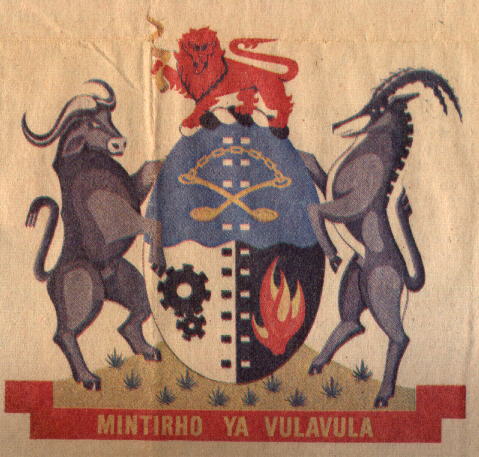Gazankulu: Difference between revisions
Knorrepoes (talk | contribs) m (Text replacement - "====Origin/meaning====" to "===Origin/meaning===") |
Knorrepoes (talk | contribs) m (Text replacement - "Incorporated into :" to "Incorporated into:") Tags: Mobile edit Mobile web edit |
||
| (3 intermediate revisions by the same user not shown) | |||
| Line 1: | Line 1: | ||
{{za}} | {{za}} | ||
'''GAZANKULU''' | '''GAZANKULU''' | ||
Incorporated into : 1994 [[Limpopo]], [[Mpumalanga]] | Incorporated into: 1994 [[Limpopo]], [[Mpumalanga]] | ||
[[File:gazankul.jpg|center|Arms (crest) of {{PAGENAME}}]] | [[File:gazankul.jpg|center|Arms (crest) of {{PAGENAME}}]] | ||
= | {| class="wikitable" | ||
|+Official blazon | |||
|- | |||
|'''Afrikaans''' | |||
| blazon wanted | |||
|- | |||
|'''English''' | |||
| blazon wanted | |||
|} | |||
===Origin/meaning=== | ===Origin/meaning=== | ||
Latest revision as of 10:06, 28 January 2024
| Heraldry of the World |
| South Africa heraldry portal Civic heraldry of South Africa |
|
GAZANKULU
Incorporated into: 1994 Limpopo, Mpumalanga
| Afrikaans | blazon wanted |
| English | blazon wanted |
Origin/meaning
The arms were officially granted on September 8, 1972.
The shape of the shield is in Nguni-style, one of the local styles.
The spoon and chain links symbolise the peace and hospitality of the people. The wheel are a symbol of industry. The black and white in the lower part symbolises the co-operation between the two peoples. The crest is the symbol of power.
The crest shows the lion, derived from the old South African arms, holding a kudu horn.
The supporters are a buffalo(Syncerus caffer) and a Roan Antelope (Hippotragus equinus).
Contact and Support
Partners:
Your logo here ?
Contact us
© since 1995, Heraldry of the World, Ralf Hartemink 
Index of the site
Literature : The Star 20-06-1975; Brownell, FG: 1998: Symbols of Sovereignty of South Africa's former Independent and Self-Governing National States.












